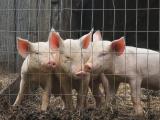Aug 5, 2010
Pandemic H1N1 and H5N1 genetically similar
A group of Japanese and US researchers has found that the 2009 pandemic H1N1 influenza virus and a contemporary H5N1 avian flu virus have a high degree of genetic compatibility. The study involved co-infecting susceptible (MDCK) cultured cells with both viruses. Their findings, they say, show that reassortment between the two viruses is likely in the event of co-infection in a susceptible host (likely swine) and could create a pandemic H5N1 virus.
http://jvi.asm.org/cgi/content/short/JVI.01140-10v1?rss
Aug 4 J Virol abstract
Study: Importance of HA and NA in pandemic vaccine
Inclusion of the neuraminidase (NA) surface glycoprotein in pandemic H1N1 influenza vaccine is likely to reduce the hemagglutinin (HA) dose required and to broaden protective immunity. Dutch researchers evaluated the efficacy of soluble, multimeric forms of 2009 H1N1 HA and NA as vaccines in ferrets. NA dramatically reduced virus replication, and HA markedly decreased clinical effects of infection; optimal protection was achieved by co-administration of both.
http://jvi.asm.org/cgi/content/short/JVI.01035-10v1?rss
Aug 4 J Virol abstract
Pandemic H1N1 was dominant flu virus in Southern Hemisphere
Researchers analyzing World Health Organization Southern Hemisphere data collected during the winter of 2009 found that the pandemic H1N1 strain almost totally displaced seasonal H1N1 in the first phase of the pandemic. Also, the rates of seasonal H3N2 influenza declined from typical levels but to a lesser extent. The authors recommend that seasonal vaccines for the coming winter include representative pandemic H1N1 and seasonal H3N2 viruses but not previously circulating seasonal H1N1.
http://tinyurl.com/eurosurv080510h1n1south
August Eurosurveillance article
Large rise in antibodies to pandemic H1N1 in Norwegians
A study from Norway found that the prevalence of antibodies to pandemic H1N1 rose from 3.2% to 44.9% from August 2009 to January 2010. Young people aged 10 to 19 had the highest prevalence, at 65.3%. Population-representative serum samples were collected before the pandemic, during the early phase, and after a nationwide vaccination program. The authors state that the high immunity to pandemic H1N1 may be enough to forestall an epidemic of the virus in Norway in the coming flu season.
http://tinyurl.com/eurosurv080510immun
August Eurosurveillance article




















